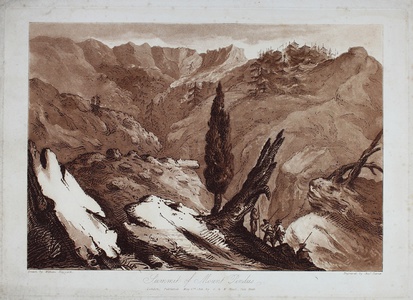| Method | Mezzotint |
| Artist | Charles Turner after William Haygarth |
| Published | London Published May 2nd 1814 by G & W. Nichol Pall Mall |
| Dimensions | Image 178 x 255 mm, Plate 207 x 292 mm, Sheet 225 x 305 mm |
| Notes |
A view from the summit of the Pindus mountain range in Northern Greece from William Haygarth's Greece: A Poem in Three Parts; with Notes, Classical Illustrations, and Sketches of the Scenery. Featuring in Part 1 of Haygarth's poem, the landscape was to accompany and illustrate the poem text on the opposite page: Of Pindus where thou dwell'st' midst solitudes Of stern sublimity: with slow slow step, Painfully press'd upon th' unyielding rock, I scale its rugged steeps the dang'rous path, Now lost behind a broken mass of crag, And now along the precipice's edge Trac'd fearfully eludes at length the eye, Its course just shewn by a long line of flocks. On whose white fleeces ev'ning's level beam Glances. Wilder and sterner to the view, The prospect opens here the torrent pours Its waters breaking into gems of foam O'er the black rock that midway in its stream Rears its rough front or round the shatter'd Of some vast tree torn from its parent cliff Curling in silv'ry eddies: there the pine Stretches his giant limbs scorch'd by the fires William Haygarth (1784-1825) was an English writer, poet and artist. The son of John Haygarth, the British physician who introduced new measures to reduce the spread of fever among patients and reduce the smallpox morality rate, Haygarth was educated at Rugby School and studied at Trinity College, Cambridge where he received a fellowship to travel through Greece. While there he joined Lord Byron's circle and whilst in Athens produced his most notable work Greece: A Poem in Three Parts. Haygarth also frequently wrote for the Quarterly Review and the British Critic. Charles Turner (1774-1857) was was an English mezzotint engraver and draughtsman. Hailing from Woodstock, Oxfordshire, Turner moved to London at the age of fifteen. He enrolled in The Royal Academy and, like many other engravers of the time, initially relied upon the patronage of wealthy and influential people. Turner had the considerable backing of the Marlborough family, for his grandmother had been a close companion of the Duchess. This relation led to important commissions. Turner would, for instance, engrave the Marlborough family portrait after the painting by Sir Joshua Reynolds. He was subsequently employed by the influential publisher John Boydell. Diversely gifted, Turner was as adept in the medium of mezzotint as he was in stipple and aquatint. This leant great scope to the subjects he could depict. Whether it was the engraving of Van Dyck or Rembrandt, or the topography of his namesake, Turner excelled. Condition: Foxing and time toning to sheet, minor creasing to corners. |
| Framing | unmounted |
| Price | £80.00 |
| Stock ID | 46054 |

